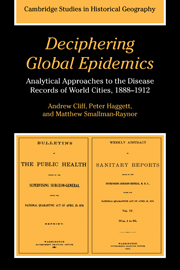 Deciphering Global Epidemics
Deciphering Global Epidemics Book contents
- Frontmatter
- Contents
- List of plates
- List of figures
- List of tables
- Foreword
- Preface
- 1 Prologue: epidemics past
- 2 The nature of the evidence
- 3 The global sample: an overall picture
- 4 Epidemic trends: a global synthesis
- 5 Comparing world regions
- 6 The individual city record
- 7 Epidemics: looking forwards
- Appendices
- A Primary data sources
- B International epidemiological sources
- C National epidemiological sources
- D International and national epidemiological agencies
- Chapter notes
- References
- Index
- Cambridge Studies in Historical Geography
A - Primary data sources
Published online by Cambridge University Press: 06 July 2010
- Frontmatter
- Contents
- List of plates
- List of figures
- List of tables
- Foreword
- Preface
- 1 Prologue: epidemics past
- 2 The nature of the evidence
- 3 The global sample: an overall picture
- 4 Epidemic trends: a global synthesis
- 5 Comparing world regions
- 6 The individual city record
- 7 Epidemics: looking forwards
- Appendices
- A Primary data sources
- B International epidemiological sources
- C National epidemiological sources
- D International and national epidemiological agencies
- Chapter notes
- References
- Index
- Cambridge Studies in Historical Geography
Summary
United States marine hospital service/public health service
Weekly Abstract
The National Quarantine Act of 1878 granted the US Marine Hospital Service, forerunner of the US Public Health Service, powers of quarantine against vessels from infected ports overseas. As described in chapter 2, the Service prepared weekly abstracts of sanitary reports received from foreign locations to assist in the exercise of the quarantine powers, and these were begun as Bulletins of the Public Health in 1878. The publication was subsequently renamed twice, first in 1887 (Weekly Abstract of Sanitary Reports) and then in 1896 (Public Health Reports), and it was to remain a principal weekly source of international (and domestic) morbidity and mortality statistics until 1912. Thereafter, international statistics continued in reduced form until 1951. In these appendices, all general references to the publication under its various aliases are as the Weekly Abstract.
The structure and content of the Weekly Abstract is outlined in chapter 2. In brief, a typical edition from the turn of the century was divided into two parts along geographical lines: United States; and Foreign and Insular. Each section was further divided into tabular and written reports. United States section: This consisted of tabulated statistics of: immigration at major ports during the week; the transactions of national, state, and municipal quarantine and inspection stations; reports of cases and deaths from quarantine diseases by state and county; estimated population and deaths from all causes, and selected infectious diseases (cholera, diphtheria, enteric fever, measles, scarlet fever, smallpox, tuberculosis, typhus fever, variola, yellow fever, and whooping cough) by city; and meteorological conditions for major cities.
- Type
- Chapter
- Information
- Deciphering Global EpidemicsAnalytical Approaches to the Disease Records of World Cities, 1888–1912, pp. 384 - 388Publisher: Cambridge University PressPrint publication year: 1998


